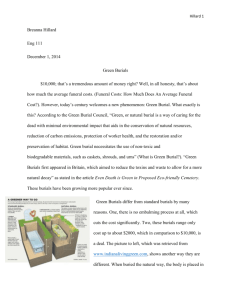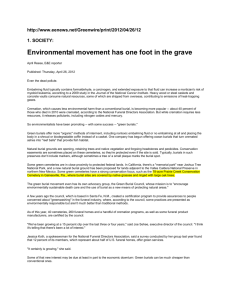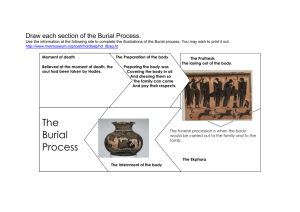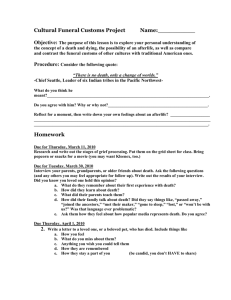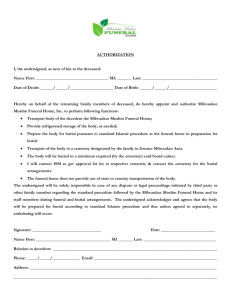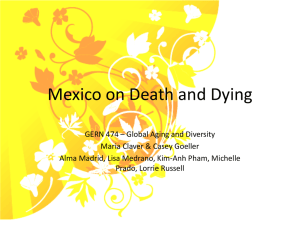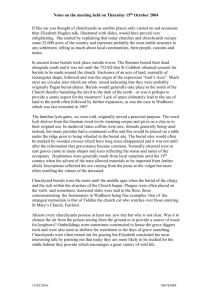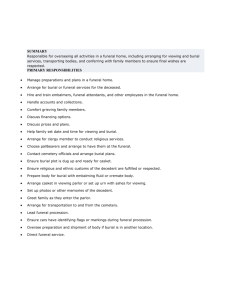Death Rituals
advertisement
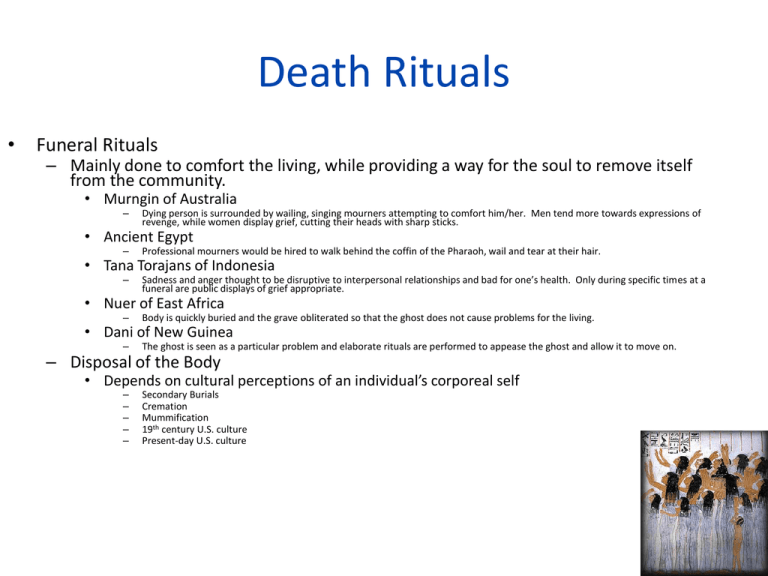
Death Rituals • Funeral Rituals – Mainly done to comfort the living, while providing a way for the soul to remove itself from the community. • Murngin of Australia – Dying person is surrounded by wailing, singing mourners attempting to comfort him/her. Men tend more towards expressions of revenge, while women display grief, cutting their heads with sharp sticks. • Ancient Egypt – Professional mourners would be hired to walk behind the coffin of the Pharaoh, wail and tear at their hair. – Sadness and anger thought to be disruptive to interpersonal relationships and bad for one’s health. Only during specific times at a funeral are public displays of grief appropriate. • Tana Torajans of Indonesia • Nuer of East Africa – Body is quickly buried and the grave obliterated so that the ghost does not cause problems for the living. – The ghost is seen as a particular problem and elaborate rituals are performed to appease the ghost and allow it to move on. • Dani of New Guinea – Disposal of the Body • Depends on cultural perceptions of an individual’s corporeal self – – – – – Secondary Burials Cremation Mummification 19th century U.S. culture Present-day U.S. culture Burials The most common disposal method. Sometimes the body may be buried quickly and not carry much meaning, as with the Nuer of East Africa. More often, the body is elaborately buried: Burial under/near dwelling or special preparation of the body was also common Ancient Egypt Predynastic (pre-3,000 B.C.E.) non-elite burials: Deceased wrapped in a shroud, placed in a small wooden coffin. Secondary Burials Secondary Burials Often marks the end of the mourning period. Commonly involves, digging up, processing and reburying the body in some way. Sometimes thought that what happens to the body also happens to the soul http://video.nationalgeographic.com/video/player/places/culture-places/beliefs-andtraditions/taiwan_secondburial.html Murngin of Australia After 2-3 months (or more) body is exhumed, bones are washed of any remaining flesh. Cleaned bones are placed in a bundle and watched over for several months, then taken out, smashed up and placed into a log which is then left to rot. relic for the family An object of religious veneration, especially a piece of the body or a personal item of religiously important person, such as an ancestor or saint. A finger or other small bone may be saved as a Cremation • Funerary practice of burning the body. Practiced for a variety of reasons: – A way to destroy the corpse, so ghost cannot haunt the living. – Reaction to the indignity of the decay process. – Economically cheaper than burial. • Yanomamö: Body is decorated, burned on a pyre in the middle of the community. Smoke is thought to be contaminating so all children and the sick leave the village during cremation. Bits of teeth and ashes saved in a hollow log to be crushed and consumed in a soup later on. – The Yanomamö are Endocannibalistic anthropophagers meaning that they eat the bodies of their own people. Mummification • • The technique of preserving a dead body involving drying and preservatives. Story time… Exposure • Getting rid of the body by leaving it to nature – Inuit: Exposure done out of necessity, ground too hard for burial – North American societies: Tree/high platform for elements. – American Southwest: Body left in cave, becomes a natural mummy – Tibet: Sky burials where body is left to be eaten by birds. U.S.A. 19th Century Death Rituals vs. Today • 19th Century Death Rituals – Person usually dies at home surrounded by friends and family. Female family members prepare the body for the funeral, create a burial shroud. Body stays in the parlor for about 3 days and is then transported the funeral home. Body would stop at church for service by a special horse-drawn carriage and then interred either on family land or a local cemetery – The African Burial Ground • Over 400 skeletons uncovered (~50% children) in Lower Manhattan, New York, perhaps as many as 10,000 people interred total. • Forensic Anthropologists :A specialist in the analysis of the human skeleton in a legal context. – Children of slaves not provided accurate food or shelter (disease and malnutrition evident in bones). – Muscle strains, tears, fractures evident on bones from carrying heavy loads. – Civil War changed everything • Massive, national cemeteries (Arlington National Cemetery). Over 600,000 died. • Embalming, used previously only on medical cadavers, was practiced on a large scale to keep servicemen intact when shipped U.S.A. 19th Century Death Rituals vs. Today • U.S. Funeral Rituals Today – Death is announced through network of friends and family – A mortician will prepare the body and the body is almost always embalmed. – Terminology has also changed: funeral director for undertaker, casket for coffin. Why is this? Why might we not be as comfortable with death as other cultures? What is our overall attitude towards death? – Roadside Memorials • Should they be allowed? Block traffic? • Sacred Remains – Even if body is damaged upon death, may have elaborate and expensive methods of reconstruction for funeral services. – Servicemen who have died overseas. The funeral is not complete without the body. Days of Death • Halloween/Eve of All Saints/All Saints Day/Samhain – Halloween – Eve of All Saints (Even of All Hallows) – All Saints Day – Samhain • Dia de los Muertos • Beautiful Feast of the Valley (Heb Nefer En Inet)
